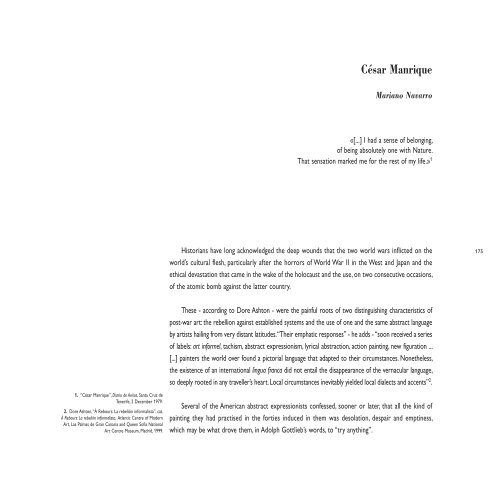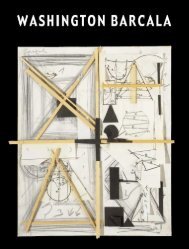VERSIÓN INGLESA ENGLISH VERSION - Fundación César Manrique
VERSIÓN INGLESA ENGLISH VERSION - Fundación César Manrique
VERSIÓN INGLESA ENGLISH VERSION - Fundación César Manrique
Create successful ePaper yourself
Turn your PDF publications into a flip-book with our unique Google optimized e-Paper software.
1. “<strong>César</strong> <strong>Manrique</strong>”, Diario de Avisos, Santa Cruz de<br />
Tenerife, 2 December 1979.<br />
2. Dore Ashton, “À Rebours: La rebelión informalista”, cat.<br />
À Rebours: La rebelión informalista, Atlantic Centre of Modern<br />
Art, Las Palmas de Gran Canaria and Queen Sofia National<br />
Art Centre Museum, Madrid, 1999.<br />
<strong>César</strong> <strong>Manrique</strong><br />
Mariano Navarro<br />
«[...] I had a sense of belonging,<br />
of being absolutely one with Nature.<br />
That sensation marked me for the rest of my life.» 1<br />
Historians have long acknowledged the deep wounds that the two world wars inflicted on the<br />
world’s cultural flesh, particularly after the horrors of World War II in the West and Japan and the<br />
ethical devastation that came in the wake of the holocaust and the use, on two consecutive occasions,<br />
of the atomic bomb against the latter country.<br />
These - according to Dore Ashton - were the painful roots of two distinguishing characteristics of<br />
post-war art: the rebellion against established systems and the use of one and the same abstract language<br />
by artists hailing from very distant latitudes. “Their emphatic responses” - he adds - “soon received a series<br />
of labels: art informel, tachism, abstract expressionism, lyrical abstraction, action painting, new figuration ...<br />
[...] painters the world over found a pictorial language that adapted to their circumstances. Nonetheless,<br />
the existence of an international lingua franca did not entail the disappearance of the vernacular language,<br />
so deeply rooted in any traveller’s heart. Local circumstances inevitably yielded local dialects and accents” 2 .<br />
Several of the American abstract expressionists confessed, sooner or later, that all the kind of<br />
painting they had practised in the forties induced in them was desolation, despair and emptiness,<br />
which may be what drove them, in Adolph Gottlieb’s words, to “try anything”.<br />
175
















![Becas y premios de la Fundación César Manrique [1997-2006]](https://img.yumpu.com/20766851/1/184x260/becas-y-premios-de-la-fundacion-cesar-manrique-1997-2006.jpg?quality=85)
